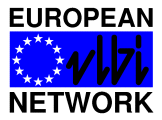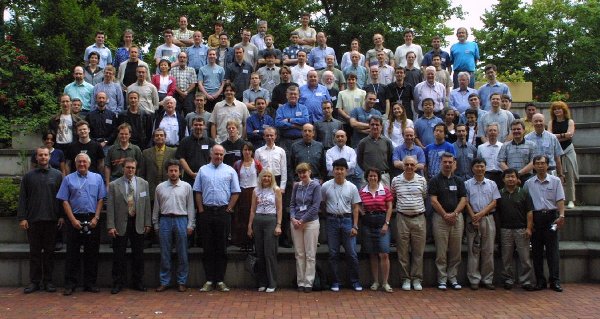
Number 3
September 2002
 |
European VLBI Network Newsletter Number 3 September 2002 |
| EVN Homepage | Publications | Meetings | User Support | Proposals | JIVE Homepage | Newsletter Archive |
| Contents | |
The summer has been a busy one for both engineering and scientific staff of the EVN. Major engineering work has been undertaken at various telescopes:
Other technical efforts have focused on the development and first successful demonstration of the new PCEVN VLBI disk system. This is discussed below in the article by Steve Parsley, but I would like to take the opportunity to thank all those involved in this project. Meanwhile, the scientists were busy at a variety of meetings over the summer. One of which, the 6th EVN Symposium, focused on the science being done with VLBI. This was a highly successful meeting, involved over 120 scientists and is reported on in more detail later in this newsletter.
Finally, I would like to report one impending personnel change. Simon Garrington's term as chairman of the EVN Programme Committee comes to an end in December of this year. On behalf of the EVN community I would like to thank him for his tremendous efforts over the last three years in ensuring that the Programme Committee remains an independent peer-review body with a strong reputation. Simon will remain on the committee as the Jodrell Bank Observatory representative. He is replaced as Chairman by Patrick Charlot of the Observatoire de Bordeaux.
Phil Diamond (pdiamond@jb.man.ac.uk)
Chairman, CBD of the EVN
Observing proposals are invited for the EVN, a VLBI network of radio telescopes in Europe and Asia operated by an international Consortium of institutes. The EVN is open to all astronomers, and encourages use of the Network by astronomers not specialised in the VLBI technique. The Joint Institute for VLBI in Europe, JIVE (www.jive.nl) can provide support and advice on project preparation, scheduling, correlation and analysis. See www.evlbi.org/support/evn_support.html.
PIs can apply for time by completing a coversheet (www.evlbi.org/proposals/prop.html) and attaching a scientific justification (maximum 2 pages). The detailed call for proposals (www.jb.man.ac.uk/vlbi/EVN/evncall-long-oct2002.html) has further information on Global VLBI, EVN+MERLIN and guidelines for proposal submission. The EVN User Guide is available at www.evlbi.org/user_guide/user_guide.html, the EVN Status table (www.oso.chalmers.se/~vlbi/EVN/EVNstatus) gives current antenna capabilities and the on-line VLBI catalogue (www.ira.bo.cnr.it/~tventuri/cata.html) details sources observed by the EVN and Global VLBI.
EVN Observing Sessions in 2002
| 2002 Session 1 | Feb 06 - Feb 27 | 18/21cm + MERLIN, 1.3cm, 6cm, S/X + ... |
| 2002 Session 2 | May 22 - Jun 12 | 18/21cm + MERLIN, 6cm, 5cm + ... |
| 2002 Session 3 | Nov 06 - Nov 27 | (provisional dates) 6cm + MERLIN, 18/21cm, S/X +... |
Proposals received by 1 October 2002 will be considered for scheduling in Session 1, 2003 or later. Finalisation of the planned observing wavelengths will depend on proposal pressure. Most proposals request 12-48hrs observing time. The EVN PC also encourages larger projects (>48 hrs) but these may be subject to additional scrutiny, and the EVN PC may, in some cases, attach conditions on the release of the data. Special features for Sessions in 2003;
An EVN Users Meeting was held during the EVN Symposium in Bonn on 26 June 2002. Simon Garrington chaired the meeting and the following summary is based on notes kindly provided by Andy Biggs (JIVE) and Ed Fomalont (NRAO).
Phil Diamond outlined his 'Action Plan' for the EVN. This is an 'end-to-end' strategy, which aims to broaden support for the EVN and make it easier to use; all the way from proposal preparation to data analysis and archive access. Michael Garrett summarised technical progress on the network, stressing the better-than-expected performance of the 512 Mb/s tests at 18cm, and encouraging users to capitalise on the high sensitivity that the combination of routine 512 Mb/s recording and large total collecting area of the EVN provides. Cormac Reynolds described the operation of the EVN pipeline, which automates almost all of the steps required in AIPS to go from a tape received from the EVN correlator to a final calibrated data set. This procedure can be used for the majority of EVN projects and the results are posted on the www.evlbi.org/pipeline web page. In this way detailed feedback on the performance of the network can be generated. There was broad support for this initiative, although many users did not want the target images to be posted on the web. Bob Campbell reported on improved station positions for EVN telescopes which are not normally part of a geodetic network. These new positions are largely based on a 6cm EVN experiment by Patrick Charlot (Bordeaux) and make a dramatic improvement to the phase referencing capability of the EVN at 6cm.
To stimulate discussion, a questionnaire was sent out by Simon Garrington. A summary of the responses is available at www.jb.man.ac.uk/~stg/evnusers2002.pdf. The discussion raised the following issues:
Simon Garrington (stg@jb.man.ac.uk)
In July 2002, JIVE and Metsähovi Radio Observatory were pleased to announce the detection of 'first fringes' from the PCEVN disk system. In a special test observation, data were recorded on tape at Jodrell Bank and on disk in parallel with tape at Westerbork (thanks to Paul Burgess and Tony Foley). Later tape-tape and tape-disk correlations on the JIVE Data Processor yielded identical fringes at 256Mb/s data rate.
The prototype system used for this demonstration comprises an ordinary, office PC equipped with the VSI interface card and software developed by Jouko Ritakari and Ari Mujunen at Metsähovi Radio Observatory. The interface to the correlator was engineered by Sergei Pogrebenko at JIVE.
The design philosophy for the PCEVN is fundamentally different from that of other disk-based data recording systems for VLBI. While other teams are designing single PC solutions for Gb/s data rates, the PCEVN gets maximum performance from a commodity PC to make a scalable system. The required data rate is achieved using multiple units. Low cost and unlimited scalability to multi-Gb/s speeds are not the only benefits of the PCEVN approach. It is especially well-suited to e-VLBI because it stores VLBI data in regular Linux files on ordinary PC hard disks.
At the heart of the system is a low-cost VSI interface board designed by the Metsähovi team. This is a standard half-size, 32-bit, 33MHz PCI expansion board that stores incoming data to PC main memory using Bus-Master DMA. The 32-bit, VSI-H standard LVDS bi-directional interface is duplicated allowing several units to be cascaded, each recording a sub-set of the input data. Further details of the VSI interface and associated software are available at http://kurp-www.hut.fi/vlbi/instr.
In the PCEVN the Metsähovi VSI core units are augmented with a Mk4 'wrapper' designed by JIVE. This unit handles the electrical interface to the Mk4 formatter and the correlator and implements a general purpose, cross-point switch allowing arbitrary routing of signals to the multiple PCs.
MRO has manufactured a sufficient number of VSIB boards to allow for testing and evaluation of the PCEVN concept. For the next phase of the project, four complete units are being assembled at JIVE and additional software created to allow two-station disk-disk record and replay tests in October. A live test alongside a normal VLBI session is planned in November.
Steve Parsley (parsley@jive.nl)
The EVN Support Group at JIVE is able to provide comprehensive support for all EVN users, including Global VLBI users. In particular, support scientists and other staff are on-hand to guide new, inexperienced (or lapsed!) users through all stages of the VLBI process:
There are various sources of financial support for users who wish to visit JIVE. In particular, users that are affiliated with an EU or EU Associate State can be funded via the European Commission's Access to Research Infrastructures programme (see EVN Newsletter No. 1, January 2002). Some travel funds may also be available to users that are affiliated to an EVN institute. More information on travel support (and user support more generally) can be obtained from the author.
Mike Garrett (garrett@jive.nl)
The 6th European VLBI Network Symposium took place in Bonn, Germany, from 25th to 28th June this year, and was hosted by the MPIfR. The meeting was held at the Gustav Stresemann Institut, a conference centre located between Bonn and Bad Godesberg, and was well attended by around 120 scientists from around the world. The program reflected well the Symposium sub-title, 'New Developments in VLBI Science and Technology', with around 100 contributions, ranging from the latest results from astronomical observations with the EVN and other VLBI arrays, to geodesy, new VLBI methods, hardware and software, and reports from planned or upgraded telescopes. As with most previous EVN Symposia, there are written proceedings of the oral and poster presentations. But, departing from normal practice, the Symposium organisers demanded the written contributions some 2 weeks beforehand and, indeed, managed to distribute hard copies to participants at the start of the Symposium. Only a handful of the presentations are not included. The proceedings are available online at www.mpifr-bonn.mpg.de/div/vlbi/evn2002/book/.

Figure 4: Participants of
the 6th European VLBI Network Symposium hosted by MPIfR in Bonn,
Germany, 25th to 28th June 2002.
|
Very fortunately the Bonn weather played along, with the scientific sessions and - more importantly - the related cultural events benefiting from four days of sunshine. These included a MPIfR versus Rest-of-the-World football match, won 4-0 by the home team. Another was a visit to, and tour of, the 100-m radio telescope in Effelsberg, followed by the Symposium Dinner held in the old town of Bad Muenstereifel. Financial support for the Symposium came from the MPIfR, the European Commissions IHP program, and from the Max Planck Research Prize for International Collaboration.
Broad categories covered in the Symposium were Geodesy, Telescopes, Software & Hardware, New Methods, AGN & Variability, AGN & Their Environment, Gravitational Lenses, Circumstellar Masers & Star-Forming Regions and the Life & Death of Stars. Important technical issues discussed included the improved EVN station positions, the US-led Mark 5 Disc-Based Gbps VLBI system and the practicalities of phase-referenced VLBI observations. To begin the conference proceedings Eugen Preuss has provided an interesting and extremely valuable guide to the development of the VLBI technique, paying particular attention to MPIfR and the Efflesberg 100-m telescope's involvement.
Studies of AGN and their host galaxies were well represented at the conference. Reports concentrated on observations of variability, proper motions, evolution and structure. Some highlights included recent VSOP polarisation images of two BL Lacs (Gabuzda) which showed longitudinal magnetic fields with rapid reversals in field direction on scales of milliarcsecs or smaller. Krichbaum et al. reported a new world record in the detection of three bright AGN at 147 GHz (2 mm), which achieved an angular resolution of ~18 microarcseconds! An encouraging paper, presented by Garrett, summarised the capabilities of the next generation of radio astronomy facilities, with particular attention to the study of distant star-forming regions. Gravitational lenses continue to be popular targets within the EVN user community. As well as hearing of recent work on the systems B0128+437, MG2016+112 and B1422+231, Bradac et al. discussed a method of extracting magnification matrices from VLBI observations. Biggs et al. also give a fuller discussion of the EVN/Global 8.4 GHz observations of the lens B0218+357 first reported in the EVN Newsletter No. 1 (January 2002). The conference also highlighted recent observations of maser sources, particularly those associated with Miras, AGB stars and star-forming regions. Other stellar objects, including pulsars, active stars, X-ray binaries (e.g. SS433; Paragi et al.) and supernovae (e.g. SN 1986J; Pérez-Torres et al.) were also well represented.
Richard Porcas (p222rwp@mpifr-bonn.mpg.de)
Alastair Gunn (agg@jb.man.ac.uk)
| The European VLBI Network (EVN) website (http://www.evlbi.org/) is hosted by the Joint Institute for VLBI in Europe (http://www.jive.nl/). |